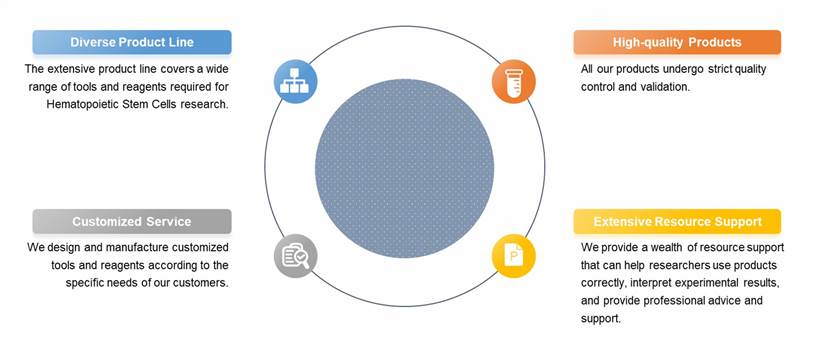Stem Cell Adhesion Molecules
Creative BioMart Stem Cell Adhesion Molecules Product List
Immunology Background
About Hematopoietic Stem Cells
Hematopoietic stem cells (HSCs) are also known as pluripotent stem cells. It is a group of primitive hematopoietic cells present in hematopoietic tissues. It can also be said to be the primordial cell of all blood cells (most of which are immune cells). Directed differentiation and proliferation of hematopoietic stem cells into different blood cell lineages and further generation of blood cells.
Human hematopoietic stem cells first appear in the yolk sac at the 2nd to 3rd week of embryonic age, migrate to the liver and spleen in the early embryonic period (2nd to 3rd month), and then migrate from the liver and spleen to the bone marrow in the 5th month. The bone marrow becomes the main source of hematopoietic stem cells at the end of the embryonic period until after birth. Hematopoietic stem cells are multipotent (both self-replicating and differentiating). In the embryo and the rapidly regenerating bone marrow, HSCs are mostly in the proliferative cycle. In normal bone marrow, they are mostly in the quiescent phase (G0). When needed by the body, some of them differentiate and mature, while others differentiate and proliferate to maintain a relatively stable number of hematopoietic stem cells.
Hematopoietic stem cells further differentiate and develop into directed stem cells of different blood cell lines. Most of the directed stem cells are in the proliferative cycle and further differentiate into various blood cell lineages, such as erythroid, granulocyte, monocyte-phagocyte, megakaryocyte, and lymphocyte lineages. Lymphocytes differentiated from hematopoietic stem cells continue to differentiate and mature into T and B cells. And cause cellular immunity and humoral immunity by T and B cells respectively. If hematopoietic stem cells are defective in the body, it can cause severe immunodeficiency diseases.
HSCs are present in adult bone marrow, peripheral blood, and cord blood. Classical studies in mice have described two hematopoietic stem cell populations: long-term and short-term. Long-term HSCs can self-renew, whereas short-term HSCs do not. Short-term HSCs, also known as progenitor or precursor cells, can differentiate into all types of blood cells that can be characterized by specific markers. For example, cells that differentiate into lymphocytes and granulocytes can be identified by detecting the expression of certain SLAM family receptors and integrin α M/CD11b, respectively.
Research Tools for Hematopoietic Stem Cells
Creative BioMart offers a wide range of products related to hematopoietic stem cells, involving the following:
Creative BioMart offers many types of products related to Hematopoietic Stem Cells, including but not limited to the ones listed below, please see the product listings page and details page for specific products.
1. Recombinant proteins
Recombinant proteins are used for various factors and regulators associated with hematopoietic stem cells. These proteins are produced using advanced recombinant DNA technology and can be used for in vitro studies and functional assays. 2.
2. Native proteins
Native proteins can also be obtained from natural sources, retaining their natural conformation and biological activity. These proteins are suitable for studying hematopoietic stem cell interactions and functions under physiological conditions.
3. Protein pre-coupled magnetic beads
It provides a convenient method for isolation, purification and enrichment of specific proteins or protein complexes associated with hematopoietic stem cells. These magnetic beads are compatible with a variety of downstream applications.
4. Cell and tissue lysates
Cell and tissue lysates derived from hematopoietic stem cells are available to researchers, providing a valuable resource for studying protein expression, signaling pathways and cellular functions in HSC.
5. Chromatography reagents
Chromatography reagents designed specifically for hematopoietic stem cell research enable efficient, high-purity purification and analysis of target proteins. These reagents are important tools for protein isolation and characterization.
6. GMP proteins
Creative BioMart offers GMP-grade proteins to ensure the highest standards of quality for clinical research, drug development and therapeutic purpose applications.
7. Lectins
We offer a wide range of lectins for various hematopoietic stem cell related studies and applications, such as for studying glycosylation patterns and interactions of hematopoietic stem cells.
8. Assay kits
A variety of assay kits are available to facilitate the detection, quantification and analysis of specific biomolecules or cellular processes associated with hematopoietic stem cells. These kits provide high sensitivity and accuracy for experimental assays.
9. Antibodies
A comprehensive collection of antibodies against a variety of targets associated with hematopoietic stem cells. These antibodies can be used in immunohistochemistry, immunofluorescence, protein blotting and other applications to detect and analyze specific proteins and cellular markers.
10. Others
In addition to the products listed above, Creative BioMart offers a range of other resources to support researchers in hematopoietic stem cell research, including customized services tailored to meet specific research needs, and a range of resources, such as participating pathways, protein functions, interacting proteins, related articles, associated articles, and related research areas.
Our Advantages

We hope that this resource page will provide you with valuable insights into research in the field of hematopoietic stem cells. For more information or inquiries, please feel free to contact us.

